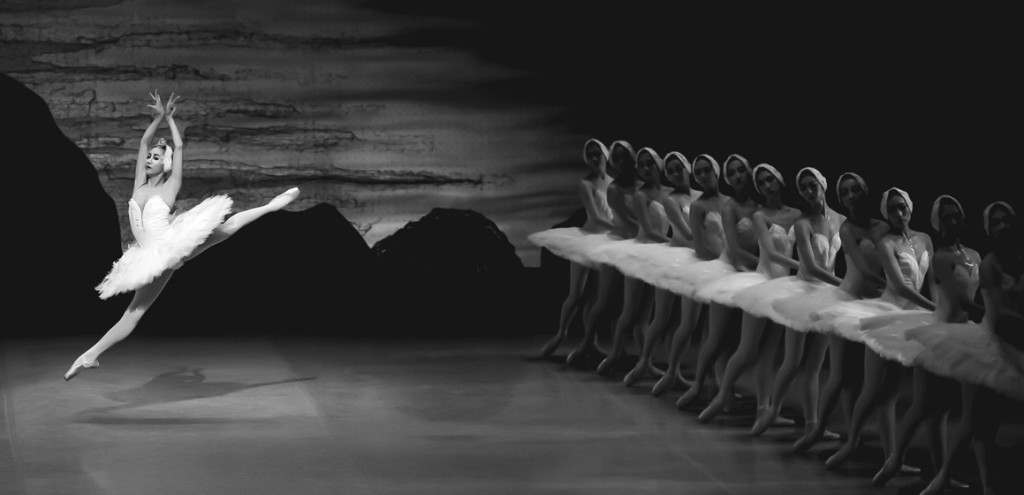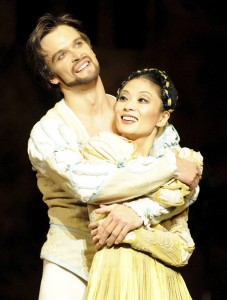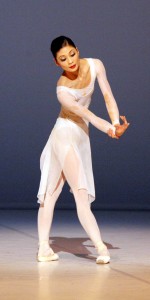The Freedom in Work: Sue Jin Kang In Stuttgart and Seoul - Vancouver Ballet Society
- Home
- Features 2015 - 2019
- The Freedom in Work: Sue Jin Kang In Stuttgart and Seoul

by Gary Smith
When Sue Jin Kang walks into the dance studio at Stuttgart Ballet there is a ripple of attention. The younger dancers stretch further, reach harder and find that special place within that allows them to be more than they already are. The more experienced principal stars of the company allow their eyes to waft over this elegant creature swathed in lavender.
When asked about dancers she admires, Kang refuses to name names. “I admire every dancer,” she says. “I love my colleagues in Stuttgart and now my dancers in Korea. Even the youngest baby in the company. I admire them all. Dancing is such hard work.”

These are the final, precious years of Kang’s career as a dancer. At 47, she has continued beyond the place most ballerinas find a comfort zone. Slim and elegant, Kang has the strength of a panther and the fragility of a butterfly. Watch her at the barre — you see intense concentration. From the moment she enters the studio to warm up for class, Kang’s love of ballet takes over, the struggle for physical perfection hidden behind those deep, dark eyes. The way she approaches class offers insight into the power of her dance. Every move is finished to the fingertips. There is nothing false.
Later, when we sit down together in the Stuttgart Ballet canteen, Kang says, “I am extremely lucky to have danced so long. Usually, when you come to the point where you’ve learned all that’s needed to be a great artist, the body is already giving out. And, yes, there is more freedom in my dance now because my mind is freer. I am happier than when I was younger because now I know what is important. It’s not about kicking my legs higher or doing lots of pirouettes.”
Kang, who was born in Seoul, Korea, in 1967, talks about her entry into the world of dance with barely disguised wonder. “When I started to go to ballet school, I simply loved to move to beautiful music.” She joined Stuttgart Ballet in 1986, and was made prima ballerina assoluta in 1997. Five people, she says, influenced her career, and she pays them tribute. “My teacher Marika Besobrasova, at the Monte Carlo Dance School, started shaping me. She danced with Mikhail Fokine’s company.” Then there’s her husband, Tunc Sökmen, a former ballet master at Stuttgart Ballet, who is now her manager. “Tunc, a dancer with Stuttgart Ballet when I joined, helped me to enter the professional life of a dancer. He showed me how to work.”
Stuttgart Ballet’s artistic director Reid Anderson and former artistic director Marcia Haydée have been huge influences. “I was privileged to work with them both as my directors. They have been my role models and mentors, Marcia especially as a dancer and Reid who has helped me so much to enter this new role of leadership.” She also mentions Georgette Tsinguirides, John Cranko’s choreologist and the keeper of his legacy, who taught Kang his ballets.

Kang has danced most of the major roles associated with Stuttgart. Her Tatiana in John Cranko’s Onegin is a deeply etched portrait of a woman tormented by what might have been. When she renounces her lover, Onegin, in the ballet’s final scene, she not only tears his missive of love in tatters, she rips her heart open with grief. In John Neumeier’s Die Kameliendame (Lady of the Camellias), when she lies back on the chaise longue, life ebbing from her fragile body, there is such regret, such sorrow, it breaks your heart. When she dances the dark heart of Kenneth MacMillan’s Song of the Earth, you understand what happens when a brilliant ballerina collides with a visceral dance role.
Asked about favourite roles, Kang says, “I love the ballets that tell a story, such as Onegin, Romeo and Juliet, The Taming of the Shrew and Die Kameliendame. I love to dive in and be the character. I love being so in the role it’s like being in another world. This is total involvement of mind, body and soul. I suppose this is what gives such tremendous satisfaction. You must give everything you have. To achieve this you must not ‘act,’ but ‘be.’ If you just act it’s superficial.”
Kang believes her long and exciting career is a result of hard work and having taken things day by day. “Even now I approach my work the same way. You must love what you do and then you can work hard and still enjoy it. Hard work is the prerequisite. You must do the maximum every day, then you have no regrets. Tomorrow it could all be over. This, in a way, is a kind of discipline.”
In 2016, Sue Jin Kang will give her farewell performances in Stuttgart. She accepted the directorship of the Korean National Ballet, a company of 65 dancers (80 if you include trainees and associates), in 2014, and since then has been dividing her time between Seoul and Stuttgart.
About her new role, she says candidly: “I never wanted to be an artistic director. I was asked. It was a tremendous honour, and I decided to take the challenge.” Now that she is committed to the change, she looks forward to it. “I notice when I am working with young dancers that every one of them is different, each has a different body, a different mentality. This is fascinating. And to be able to give to others is rewarding. I can pass on my knowledge, encourage them and, yes, challenge them.”

The Korean National Ballet has an extensive repertoire that includes everything from Rudolf Nureyev’s The Sleeping Beauty to Mats Ek’s Carmen, to works by Balanchine and Grigorovich. With her many ballet connections, Kang will also have access to new and notable works.
“Most important to me is to make the company strong from the inside. To ensure teamwork among dancers and staff.To strengthen each individual. They all make the company. When we are all going together in one direction we can be successful.”
Kang is philosophical about returning to Korea after so many years in Germany. “I don’t dwell on comings and goings. For me, the work is everything. Going home or leaving Stuttgart, these are things that happen on the way to work and dance. The work doesn’t change.” As an artistic director, Kang strives to avoid a dictatorial approach. “Discipline has to come from within, not from outside. Young dancers’ responsibility is first to themselves and then to the public.”
To all young dancers, Kang advises, “If you choose this profession you have to realize that from nothing comes nothing. Enjoy the work. That is the basis. It is beautiful in and of itself. It always comes back to working hard.” Yet, “there can be freedom within this,” Kang explains. “Freedom comes from the love of what you are doing.” Kang notes that the world of ballet has changed since she first began dancing. “There is much more diversity in the repertoires. This is harder because you have to digest a lot. Today, in a first-class international company, you must be able to dance everything. You have to be open, flexible in mind and body.”

Classical training remains the base. “If a dancer is intelligent,” she says, “this diversity can make him or her stronger. But, of course, it is double the work.” She stresses that contemporary dancing doesn’t mean forgetting classical training. “When you have been dancing a lot of contemporary work, though, it is hard to come back to classical pieces, which is why you have to always keep that side of things on a high level. That’s why there is such need for a rigorous daily class.”
A great dance actress, Kang will work to motivate the company she now heads to find depths of emotion and drama in ballet. “I’m not just interested in steps. Having worked with John Neumeier, Marcia Haydée and Georgette Tsinguirides, this is in my DNA, in my blood. Now I have the opportunity to pass it on. It takes time to learn that what counts isn’t the steps, but the feeling, the expression, the release of the soul into the performance. The steps must come as naturally as breathing. Then you can transcend them and be the character.”
When asked about dancers she admires, Kang refuses to name names. “I admire every dancer,” she says. “I love my colleagues in Stuttgart and now my dancers in Korea. Even the youngest baby in the company. I admire them all. Dancing is such hard work.”

